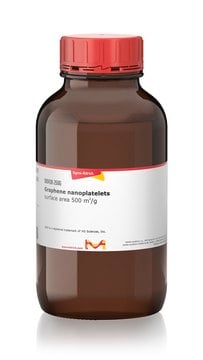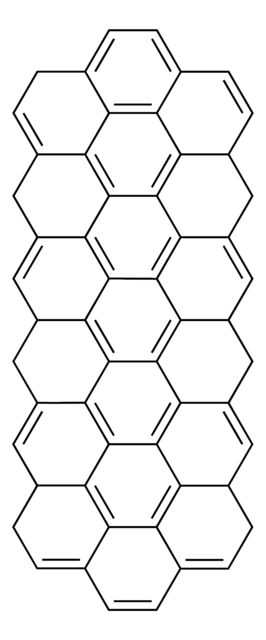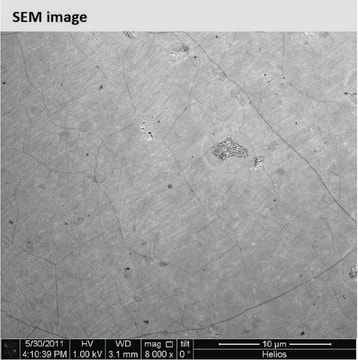Products may be shipped at a different temperature than the recommended long-term storage temperature. If the product quality is sensitive to short-term exposure to conditions other than the recommended long-term storage, it will be shipped on wet or dry-ice. If the product quality is NOT affected by short-term exposure to conditions other than the recommended long-term storage, it will be shipped at ambient temperature. As shipping routes are configured for minimum transit times, shipping at ambient temperature helps control shipping costs for our customers. For more information, please refer to the Storage and Transport Conditions document: https://www.sigmaaldrich.com/deepweb/assets/sigmaaldrich/marketing/global/documents/316/622/storage-transport-conditions-mk.pdf
900561
Graphene
powder, electrical conductivity >103 S/m, avg. no. of layers, < 3
Sinonimo/i:
few layers graphene, graphene powder
Scegli un formato
About This Item
Prodotti consigliati
Livello qualitativo
Stato
powder
Caratteristiche
avg. no. of layers< 3
Area superficiale
>500 m2/g , BET
Cerchi prodotti simili? Visita Guida al confronto tra prodotti
Categorie correlate
Descrizione generale
- Thickness: <3 layers.
- Lateral size : 0.5-5 μm.
Applicazioni
Graphene/polyaniline nanocomposites- modified electrodes can be used for the determination of heavy metals.
Heat-treated graphene nanosheets can be used to prepare solid adsorbents for rapid and selective CO2 capture applications.
Caratteristiche e vantaggi
- Superior electrical conductivity
- Large surface area
- High mechanical strength
- High degree of flexibility
Codice della classe di stoccaggio
13 - Non Combustible Solids
Classe di pericolosità dell'acqua (WGK)
WGK 3
Punto d’infiammabilità (°F)
Not applicable
Punto d’infiammabilità (°C)
Not applicable
Scegli una delle versioni più recenti:
Certificati d'analisi (COA)
Non trovi la versione di tuo interesse?
Se hai bisogno di una versione specifica, puoi cercare il certificato tramite il numero di lotto.
Possiedi già questo prodotto?
I documenti relativi ai prodotti acquistati recentemente sono disponibili nell’Archivio dei documenti.
Articoli
Self-healing soft electronic materials offer potential cost savings and reduced electronic waste.
Advances in scalable synthesis and processing of two-dimensional materials
Contenuto correlato
Batterie, celle a combustibile e supercondensatori sfruttano reazioni elettrochimiche per produrre o immagazzinare energia. Scoprite come funzionano e il concetto di trasporto separato di elettroni e ioni.
Batteries, fuel cells, and supercapacitors rely on electrochemical energy production. Understand their operation and electron/ion transport separation.
-
How is shipping temperature determined? And how is it related to the product storage temperature?
1 answer-
Helpful?
-
-
How can I determine the shelf life / expiration / retest date of this product?
1 answer-
If this product has an expiration or retest date, it will be shown on the Certificate of Analysis (COA, CofA). If there is no retest or expiration date listed on the product's COA, we do not have suitable stability data to determine a shelf life. For these products, the only date on the COA will be the release date; a retest, expiration, or use-by-date will not be displayed.
For all products, we recommend handling per defined conditions as printed in our product literature and website product descriptions. We recommend that products should be routinely inspected by customers to ensure they perform as expected.
For products without retest or expiration dates, our standard warranty of 1 year from the date of shipment is applicable.
For more information, please refer to the Product Dating Information document: https://www.sigmaaldrich.com/deepweb/assets/sigmaaldrich/marketing/global/documents/449/386/product-dating-information-mk.pdfHelpful?
-
-
What is the particle size??
1 answer-
As reported in the 'DESCRIPTION' section of the product page, the lateral size range is 0.5-5 μm.
Helpful?
-
-
What chemical can completely degrade Graphene?
What chemical can completely degrade Graphene?
1 answer-
Potassium permanganate has the potential to oxidize graphene and ultimately completely etch the entire graphene to form MnO2, as detailed in the following paper; https://pubs.acs.org/doi/pdf/10.1021/nn101857y?src=getftr
Helpful?
-
Active Filters
Il team dei nostri ricercatori vanta grande esperienza in tutte le aree della ricerca quali Life Science, scienza dei materiali, sintesi chimica, cromatografia, discipline analitiche, ecc..
Contatta l'Assistenza Tecnica.







